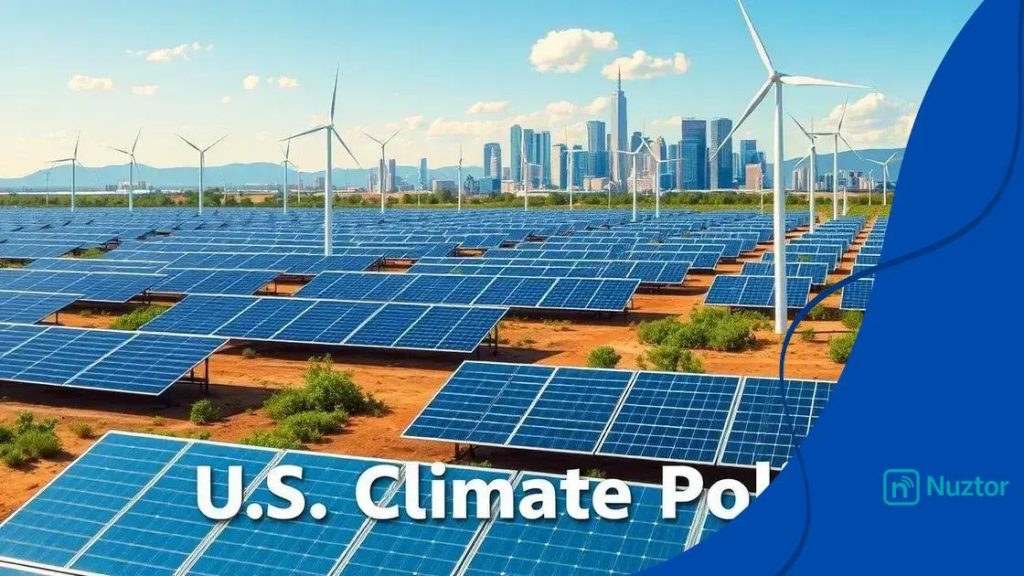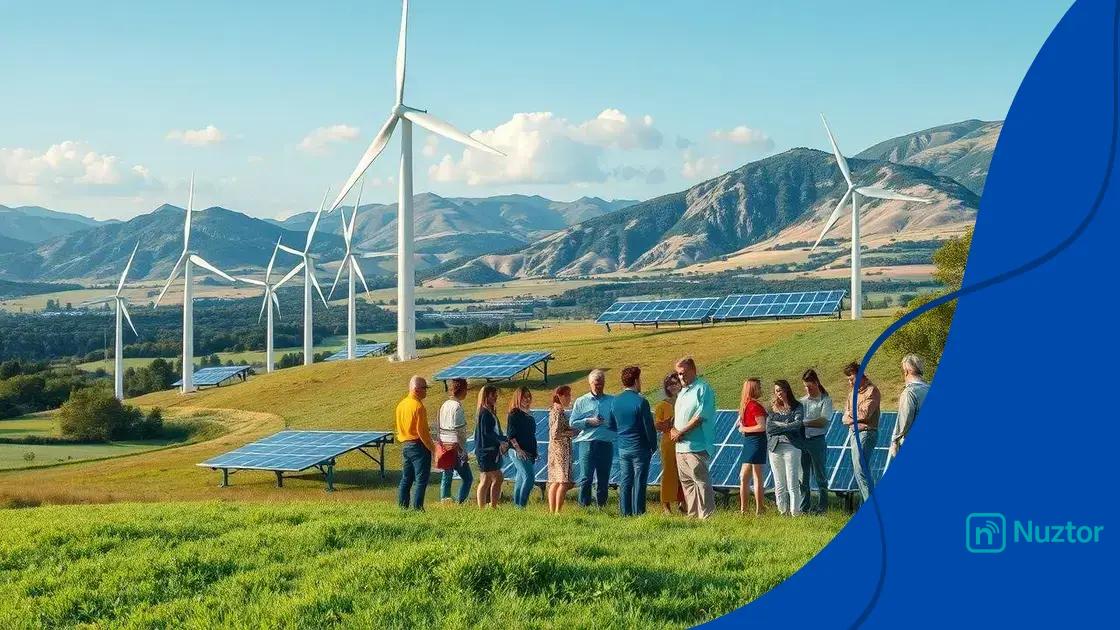U.S. climate policy plans for 2025: what to expect

U.S. climate policy plans for 2025 aim to reduce greenhouse gas emissions by at least 50%, expand renewable energy sources, and enhance public engagement to ensure a sustainable future.
U.S. climate policy plans for 2025 will play a crucial role in shaping the country’s environmental future. But what can we truly expect in terms of implementation and impact? Let’s dive into the details!
Current U.S. climate policies
The Current U.S. climate policies play a vital role in addressing environmental challenges and laying the groundwork for future initiatives. These policies aim to reduce greenhouse gas emissions and promote sustainable energy solutions.
One significant aspect of U.S. climate policies is the focus on renewable energy sources. This includes increasing investments in solar and wind energy, which are crucial for creating a cleaner energy grid. Furthermore, regulations are evolving to support electric vehicles and improve energy efficiency across various sectors.
Key Components of Current Policies
Several key components shape the landscape of U.S. climate policies today:
- Emission reduction targets set for various industries.
- Incentives for clean energy investments.
- Support for research and development in green technology.
- Regulatory measures aimed at limiting pollution.
Moreover, public awareness and participation are important in driving these policies forward. Engaging communities in sustainability efforts can significantly enhance the effectiveness of climate strategies. Education on climate change impacts can motivate proactive involvement in local initiatives.
Challenges and Opportunities
While there are numerous advancements, challenges persist. Political differences often influence the progress of climate policies, as do economic considerations. Nevertheless, the growing momentum towards sustainable solutions presents real opportunities for innovation and collaboration.
In conclusion, understanding the Current U.S. climate policies reveals the complexity and commitment towards achieving a sustainable future. By navigating these policies wisely, the U.S. can make strides that benefit the environment and public health alike.
Goals for 2025 and beyond
The Goals for 2025 and beyond are essential for driving the U.S. toward a sustainable future. These goals aim to significantly combat climate change and promote environmental stability.
A key focus will be on reducing greenhouse gas emissions. The plan is to take concrete steps to achieve a reduction of at least 50% by 2030. This ambitious target encourages innovation in clean technologies and fosters economic growth in the renewable energy sector.
Specific Goals to Achieve
To realize these targets, several specific goals have been outlined:
- Expand renewable energy capacity by increasing solar and wind installations.
- Improve energy efficiency in homes and businesses.
- Encourage electric vehicle adoption through incentives and infrastructure development.
- Enhance investment in sustainable agriculture practices.
Furthermore, collaboration with state and local governments will be crucial. Each state will have tailored plans that align with national targets while addressing unique regional challenges. Engaging with communities can also lead to greater awareness and participation in sustainability measures.
The Role of Technology
Technology will play a central role in accomplishing these goals. Advances in battery storage, grid modernization, and carbon capture can help meet energy demands while reducing emissions. As innovative solutions are developed, they will provide practical ways for individuals and businesses to contribute to climate action.
Ultimately, the Goals for 2025 and beyond reflect a comprehensive approach to addressing climate change. By setting measurable targets, the U.S. can mobilize resources and unite communities in a collective effort for a healthier planet.
Impact on renewable energy development

The impact on renewable energy development due to evolving U.S. climate policies is significant. As these policies become more ambitious, they create opportunities for advancements in technology and a shift away from fossil fuels.
Renewable energy sources like solar, wind, and hydropower are receiving increased attention and investment. This encourages innovation, making renewable options more accessible and cost-effective. With government incentives promoting clean energy projects, businesses are more motivated to invest in these sustainable solutions.
Key Effects on the Industry
Several key effects of these policies on the renewable energy industry include:
- Increased job creation in the green energy sector.
- Development of more efficient technology and infrastructure.
- A growing market for electric vehicles and associated technologies.
- Enhanced competitiveness of renewable sources against traditional energy.
Furthermore, public and private sectors are collaborating more closely to develop cleaner energy solutions. For instance, partnerships between governments and private firms boost research and development efforts. Such collaborations are critical, as they help leverage resources and expertise needed to tackle climate change effectively.
Challenges Faced
Despite the progress, there are challenges to overcome. The transition to renewable energy requires substantial investment and a skilled workforce. There are also issues related to energy storage and grid integration, which need attention as demand for renewable sources grows.
Ultimately, the impact on renewable energy development reflects the potential for a more sustainable energy future. By addressing the challenges and seizing the opportunities, the U.S. can lead the way in global efforts to combat climate change.
Challenges facing implementation
The challenges facing implementation of U.S. climate policies are significant and complex. As ambitious goals are set for the future, several hurdles need to be addressed to ensure effective execution.
One major challenge is the need for funding. Transitioning to renewable energy sources requires substantial investment in new technologies and infrastructure. Both public and private sectors must collaborate to secure necessary financing. In addition, policies must navigate through varied political landscapes, where support can waver depending on administration changes.
Key Obstacles Identified
Among the various challenges, several key obstacles have been identified:
- Diverse interests from stakeholders, including businesses and environmental groups, can lead to conflicts.
- Local and state regulations may differ, complicating national initiatives.
- Public skepticism about climate change impacts and the benefits of renewable energy.
- Technological limitations related to energy storage and grid reliability.
Public perception plays a crucial role as well. Some individuals may resist changes due to fears about job losses in traditional energy industries. To address this, policies need to emphasize the opportunities created by new technologies and sectors. Education and outreach are essential for informing communities about the benefits of climate initiatives.
Regulatory and Technological Barriers
Regulatory issues are also tricky. Regulations can be slow to change, creating a lag between policy goals and real-world developments. Moreover, technological advancements must keep pace with policy aspirations. Research and development in energy technologies need to be prioritized to overcome limitations. As innovation occurs, it can help streamline the transition and make renewable energy sources more viable.
In summary, understanding the challenges facing implementation can provide insights into how these obstacles may be addressed. By recognizing these challenges, stakeholders can work collaboratively to create effective solutions, paving the way for a smoother transition to a sustainable future.
Public opinion and engagement strategies
Understanding public opinion and engagement strategies is essential for successful climate policy implementation. As climate issues often evoke diverse opinions, it is crucial to gauge public sentiment and encourage active participation.
One effective way to engage the public is through education campaigns. These campaigns can raise awareness of climate change impacts and promote the benefits of renewable energy. By providing clear information, communities can make informed decisions and support necessary changes.
Strategies for Engaging the Community
Some effective strategies for public engagement include:
- Hosting community forums and workshops to discuss climate policies.
- Utilizing social media platforms to share information and updates.
- Partnering with local organizations to reach broader audiences.
- Creating educational materials that simplify complex policy topics.
Additionally, involving the community in decision-making can foster greater support. When people feel their voices are heard, they are more likely to embrace climate initiatives. Surveys and feedback forums can help policymakers understand public concerns and expectations.
Importance of Transparency
Transparency also plays a key role in building trust between the public and policymakers. By openly sharing data and decision-making processes, government officials can create an environment of accountability. Providing regular updates increases public confidence and participation in initiatives.
Moreover, addressing misinformation is vital. Misinformation can hinder progress and create distrust. Clear communication that debunks myths surrounding climate change helps maintain public support for necessary measures. Focus on factual evidence and success stories to illustrate real-world benefits of climate policies.
In summary, effective public opinion and engagement strategies can significantly influence the success of climate policies. By fostering communication and transparency, stakeholders can create a collaborative environment that empowers communities to actively participate in creating a sustainable future.
In conclusion, the journey towards effective U.S. climate policy is complex but essential. By setting clear goals and engaging the public, we can tackle climate change together. Overcoming challenges is vital for advancing renewable energy and fostering community support. With the right strategies, we can build a sustainable future for generations to come.
\n\n\n
| Topic | Key Takeaways |
|---|---|
| 🌍 Public Engagement | Community involvement is crucial for support. |
| ⚡ Overcoming Challenges | Addressing funding and regulation hurdles is key. |
| 📚 Importance of Education | Education enhances awareness and supports policies. |
| 🛠️ Technological Advancements | Innovation is essential for renewable energy growth. |
| 🌱 Future Outlook | A collaborative approach can ensure a sustainable world. |
\n
\n
FAQ – Frequently Asked Questions about U.S. Climate Policy Plans for 2025
What are the main goals of U.S. climate policy for 2025?
The main goals include reducing greenhouse gas emissions by at least 50%, expanding renewable energy capacity, and improving energy efficiency.
How can public opinion affect climate policy implementation?
Public opinion plays a significant role as community support leads to effective policy measures and greater participation in sustainability efforts.
What challenges are faced in implementing renewable energy policies?
Challenges include securing funding, navigating political differences, and overcoming technological limitations in energy storage and infrastructure.
How can individuals engage with climate policies?
Individuals can engage by participating in community forums, supporting education campaigns, and advocating for local sustainability initiatives.